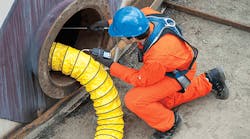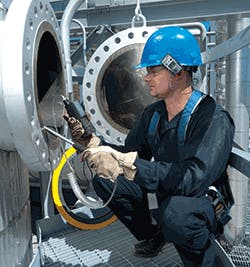Confined Spaces in Construction – A Giant Step Toward Closing the Gaps in Safety
On May 4, OSHA announced an addition to 29 CFR 1926, the federal safety standards governing the construction industry. The rules for entering confined spaces specified in Subpart AA took effect Aug. 3, and represent a leap forward in efforts to protect construction workers who enter confined spaces as part of their daily duties.
To help understand the reasons behind the new rules, let's take a giant step back in time.
Twenty-two years ago, OSHA introduced industry to the first regulations designed to protect workers entering confined spaces. OSHA standard 29 CFR 1910.146 clearly told us what a permit-required confined space was and dictated the rules for entry, particularly the requirements for testing and ensuring that the atmosphere inside the space would allow a worker to enter it safely.
However, there was a gap: 29 CFR 1910 stated the guidelines for safety in general industry, but niche industries like construction were governed by other industry-specific OSHA standards and were not directly impacted by the new rules.
The gap was obvious years later. Department of Labor statistics showed that from 2005-2009, 61 percent of all confined space fatalities occurred during construction, cleaning or repairing activities.
Closing the Gap
Now, with the new construction rules introduced this year, the gap finally is closed. For the most part, the rules are very familiar.
The definition of a permit-required confined space in construction is the same as a permit-required confined space in any other industry. The space is not designed for human occupancy, has limited means of entry or egress and has the potential to contain a hazardous atmosphere. The requirements for pre-entry testing are the same, too. The atmosphere inside the space must be tested using a calibrated, direct reading instrument for oxygen content, flammable gases and vapors and for potential toxic air contaminants, in that order. OSHA does take a step forward by clearly stating that the worker entering the space must be provided an opportunity to witness the testing that is intended to ensure his or her safety.
But what happens after the testing and initial entry of the space according to the 1993 industry rules has been considered to be vague at best. Under the general industry standard, it has been common to perform a pre-entry atmospheric test, complete the permit and put the gas monitor away until the next confined space entry.
The 2015 standard closes that gap as well. 29 CFR1926.1203 clearly states that:
". . .the atmosphere within the space must be continuously monitored unless the entry employer can demonstrate that equipment for continuous monitoring is not commercially available or periodic monitoring is sufficient. If continuous monitoring is used, the employer must ensure that the monitoring equipment has an alarm that will notify all entrants if a specified atmospheric threshold is achieved, or that an employee will check the monitor with sufficient frequency to ensure that entrants have adequate time to escape. If continuous monitoring is not used, periodic monitoring is required. All monitoring must ensure that the continuous forced air ventilation is preventing the accumulation of a hazardous atmosphere."
The rule leaves little room for interpretation and once again, OSHA has reiterated that the entry worker is entitled to, and must be given, the opportunity to witness the testing intended for his protection.
Step Toward Best Practices
The new construction standard not only closes the gap in construction safety left by the general industry standards, it represents a giant step toward implementing best practices in confined space entry. Just as there were gaps in the standards between industries, there were gaps between what would be required to comply with the standards and what would be considered best work practices for safety. The requirement for continuous monitoring during entry and for workers to be able to witness the testing processes and results are clearly steps in that direction.
The standards themselves give no direction. OSHA interpretations have always been that "calibrated" means that a monitor is calibrated and maintained according to the manufacturer's recommendations. But is this good enough? Can this be considered a best practice or is it still only minimum compliance?
What about functional testing, or "bump testing" as it is known in the industry? It is not mentioned in the regulations at all. Should the standards leave the rulemaking up to the equipment manufacturers when it comes to ensuring that monitors used for critical atmospheric testing are functioning properly and accurately each time they are used?
May 4, 2015 was a landmark day in construction safety, and hopefully the rules established there will spill over and be adopted in every other industry. The gaps in confined space safety certainly have narrowed. When all of the existing gaps have been closed, we will have taken an even larger step toward ensuring that everyone who enters a confined space will exit it at the end of the day alive.
David D. Wagner is global director of product knowledge & iNet product manager for Industrial Scientific Corp., Pittsburgh, Pa.

